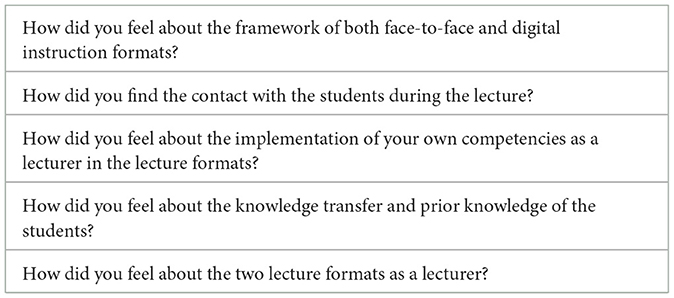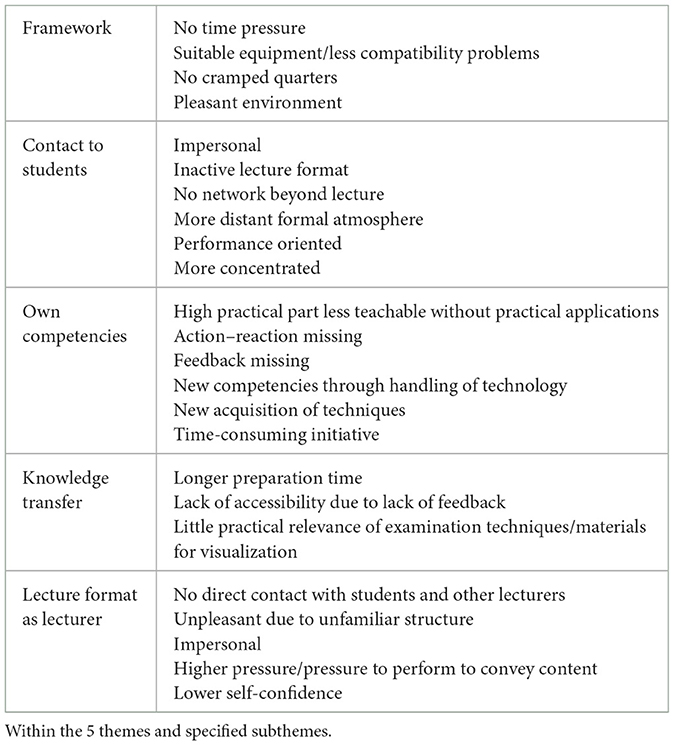- 1Department of Obstetrics and Gynaecology, University Hospital Jena, Jena, Germany
- 2Orthopedic Department, University Hospital Jena, Eisenberg, Germany
- 3Clinic for Traumatology and Orthopedics, Bundeswehr Hospital Berlin, Berlin, Germany
- 4Dieter Scheffner Center for Medical Education and Educational Research, Charité–Universitätsmedizin Berlin, Berlin, Germany
- 5Modul Integration Optics, Jenoptik Light and Optics Devision, Jena, Germany
- 6Practice for Orthopedics and Shoulder Surgery Leipzig, Leipzig, Germany
- 7Department of Trauma, Hand and Reconstructive Surgery, Jena University Hospital, Friedrich Schiller University Jena, Halle (Saale), Germany
- 8Department of Orthopedic and Trauma Surgery, Martin-Luther University Halle-Wittenberg, Halle (Saale), Germany
Background: During the coronavirus disease 2019 (COVID-19) crisis, many things changed in universities around the world. In-person learning was not possible. Instead, courses were offered in digital form. The sudden change posed enormous challenges to universities, students, and teachers. The aim of this study was to investigate the disadvantages as well as the advantages and opportunities of digital learning.
Objective: This study investigated the evaluation of an elective module by medical students and teachers in the traditional in-person and virtual teaching forms during the COVID-19 pandemic.
Methods: Using the elective module “Sports Medicine,” which includes both lectures and practical units, the opinions of the medical students about conventional teaching compared to digital instruction were evaluated. In the winter semester of 2019/2020, all classes were taught face-to-face but had to be switched to virtual teaching in the summer semester of 2020 on an ad hoc basis due to the pandemic. The students were asked to answer questions on general conditions, participant behavior, instructor evaluation, skill acquisition, topic selection, and overall evaluation after both forms of teaching. Likewise, the lecturers of both courses were queried in semiqualitative interviews about the same topics. Descriptive data analysis was performed to process the data.
Results: The students perceived digital teaching to be superior in most subareas compared to in-person teaching in terms of framework, instructor evaluation, skill acquisition, topic selection, and overall rating. Medical students seemed to feel better with digital teaching in most areas of evaluation. The lecturers found the new form of teaching rather unsettling and criticized the lack of verbal and especially nonverbal communication as well as the short preparation time for the new challenge. The instructors were uncomfortable with some aspects of the virtual teaching format.
Conclusion: In the wake of the COVID-19 pandemic, medical schools should rapidly digitize their teaching offerings and support faculty members in their computer-based competence with continuing education opportunities and time resources.
Introduction
Severe acute respiratory syndrome coronavirus 2 (SARS-CoV-2), which caused COVID-19, is one of the most aggressive and deadly infectious diseases (1). COVID-19 was declared a pandemic by the WHO on 30 January 2020 (2). Therefore, most countries implemented physical distancing measures to decelerate the infection rate (3–5). The pandemic dramatically disrupted many areas of life. Teaching was digitized in most medical schools to prevent the rotation of students between departments and hospitals, which might cause them to become potential vectors in the transmission of the disease (6). Previous formats for imparting knowledge such as lectures, seminars, group lessons, and practical exercises have to be terminated and abruptly converted into online-based variants (7). This change required consideration from both sides, the teachers and the students. In a very short time, the whole world was dealing with the challenge of maintaining high-quality education through new digital platforms. There have been no historical records of such a vast sudden shift toward e-learning (8). It has long been acknowledged that online instructional methods are efficient tools for learning (9). However, aspects such as limited nonverbal communication, limited interaction between students and professors, accessibility of materials, and time management were also discussed as critical influencing factors of the students' opinions on online courses (10). The main difference between traditional and online-learning sessions is that the latter allows students to learn from their preferred locations (11, 12). Technological solutions allow lessons to be delivered to groups and real-time processing of individual student responses. Online meeting tools like virtual web-based platforms such as Zoom®, GoToMeeting, WebEx Meeting, Adobe Connect, and many more can be used for providing instructions. They also allow synchronous sessions and multiple users to participate at the same time (13). The instructor of the session must plan for the learning curve required for students to use virtual web-based platforms effectively and not assume that all students have the necessary practical knowledge to use them. In addition, students may engage in other activities during the lecture and not actively participate. However, there are concerns that practical medical content will be rather poorly delivered through digital forms of instruction (14, 15). The fruitful use of technology in medical education depends on the willingness and expertise of the faculty to use this technology to facilitate learning. Training physicians with these skills requires a break from traditional teaching methodology (16). Therefore, it seems that training in the mastery of computer technology is a neglected skill among faculties that should be mandatory for the improvement of medical universities. An organized and clear institutional approach is needed to formulate a well-regulated and efficient system that can facilitate the adoption of structured methods by faculty members during the implementation of an online-learning module (17).
The aim of this study was to evaluate the students' and lecturers' perspectives on digital and conventional teaching of a well-established elective module at a mid-sized multicultural German medical school.
Methods
Study setting
This mixed-methods study took place at the medical school of a German University hospital in the context of the quick change from traditional teaching to digital teaching due to the COVID-19 pandemic, which was realized in 2020. At the time of the study, approximately 2090 students were enrolled at the medical school. Sample calculation was not carried out but was defined based on the course participants. Digital teaching in medical studies has not been regularly practiced there before. During clinical semesters, undergraduate students in the third to the fifth year of training must choose elective modules from a variety of course programs covering different medical fields that are usually not covered by the mandatory curriculum. The modules are in direct competition with the students' interests and comprise 28 teaching hours (45 min each). Each student must attend at least 80 lectures in an elective subject. Only the most-selected modules by the students were taught. Due to the COVID-19 pandemic, lectures had to be converted into a digital format in a very short time for them to take place. Some lectures could not be completely digitized and many had to be canceled. In the elective module “Sports Medicine,” 14 events of 90 min each were held by three lecturers in person. After conversion to an internet web-based platform, the lectures took place in a slimmed-down version with eight events of 45 min with the same three lecturers. The elective is a multifaceted teaching format consisting of practical applications, case studies, and demonstration of examination methods from the field of sports medicine.
Study design
A mixed-methods approach was chosen that consists of an abductive qualitative study based on semi-structured interviews and a cross-sectional study using course evaluation questionnaires at the end of the course. An abductive analysis of the interview transcripts and the results of the open-ended questions of the faculty questionnaire was conducted to identify the predominant themes (18). The predefined themes included teaching formats and learning objectives. Qualitative data included interview transcripts and results of the open-ended questionnaires. For the qualitative interviews, we did not test whether saturation was achieved because only 3 interviewees participated in digital and face-to-face instructions. Items from the questionnaire with a five-point Likert scale as the response format were considered quantitative data. The use of the mixed method was deliberately chosen by the authors for this study so that the qualitative and quantitative research approaches can be combined to address the specific research interest, namely the influence of digital teaching during the COVID-19 pandemic in direct comparison to face-to-face teaching in medical higher education with complex, practice-oriented teaching in the clinical section. The mixed methods approach allows our research question to be viewed from different perspectives (students and lecturers).
Ethical approval and consent to participate
The ethical approval for this study was granted by the local ethics committee of the University of Jena (2019–1456–Bef). Participation in the study was voluntary. Informed consent for the study was obtained by voluntarily submitting the questionnaire. Written informed consent was obtained regarding the voluntary nature of participation and all data were collected anonymously. Minor participants were not represented in the cohort. The ethics committee explicitly waived the requirement for written informed consent from participants.
Inclusion and exclusion criteria
The inclusion criteria for the students were as follows: must be over the age of 18 years, must be a student of Human Medicine at the University of Jena in the clinical section, and must participate in the elective subject tutorial Sports Medicine. The inclusion criteria for the lecturers were as follows: must be over the age of 18 years and must be a lecturer of Human Medicine at the University of Jena for the elective subject tutorial Sports Medicine.
Data collection
Between December 2020 and February 2021, semi-structured interviews with three lecturers of both face-to-face and digital lessons in the elective module “sports medicine” were conducted. We developed the interview guidelines according to the questions (Table 1) and tested and adjusted the questions during pilot interviews within the research team. The interviews were conducted in German via phone calls and were recorded and transcribed by the interviewer. The median interview length was 19 min (range 11–28 min). The questions were asked in German.
Students' evaluation
The standardized student evaluation takes place at the end of the elective subject tutorial sports medicine. The student evaluation questionnaire was given to the students on the last day of the module as a paper version for the in-person lessons (n = 25) in January of the winter semester 2019/2020, i.e., before the pandemic and digitally for the virtual lessons (n = 26) in July of the summer semester 2020, i.e., during the pandemic. No incentive or compensation was given to the survey participants. There was a difference in the number of students who attended the face-to-face and digital format lectures. This was due to logistical circumstances. Before the start of the respective elective, the maximum number of participants is determined by the medical faculty. For the in-person attendance phase, the maximum number of students was 25 and for the digital format, the maximum number of students was 26. The evaluation form included 29 questions using a Likert scale (1 = strongly disagree, 2 = disagree, 3 = undecided, 4 = agree, and 5 = strongly agree) regarding the framework conditions of the lessons (5 questions), the participants and their behavior (3 questions), the lecturers and their structure of the lecture (6 questions), the qualification, which could be imparted by the lecture (7 questions), the interest of the students and their assessment of the rate of referrals and existing knowledge (4 questions), and the overall assessment of satisfaction with the lecture (4 questions). Furthermore, the students were asked about some epidemiological data, the time required for preparation, the expected amount of work, and the amount of work performed. A place for open comments about good and bad findings at the lectures was provided. The questions were asked in German.
Data analysis
We performed an abductive analysis of the interview transcripts and the results of the open-ended questions from the lecturers and students to identify the predominant themes. Descriptive data analysis of the questionnaire items was conducted using Microsoft Excel 2020 (version 16.35). The P-values were calculated using the Mann–Whitney U test with the Statistical Package for the Social Sciences, SPSS (version 17.0, SPSS Inc. Chicago, IL, USA). A P-value of < 0.05 was considered significant.
Response-bias
To reduce bias errors, the research design was constructed in such a way that the respondents are not exposed to intentional or unintentional misrepresentations. Due to the maximum anonymity of the survey, the questionnaires were answered without personal contact with the lecturers as the questionnaires were distributed and collected again by independent members of the medical faculty (questionnaires on paper) or the questionnaires were digitally distributed directly to the students (online). The faculty interviews were conducted by an independent person who is also a member of the medical faculty. The study participants had enough time to fill in the questionnaires. The questionnaire for the students was previously tested on a small group of 10 students. The questions were then modified. The questions for the lecturers were created according to a standardized scheme (see Methods section). The possible number of lecturers is only three as only they were allowed to teach the elective subject. All three lecturers participated in the interview.
Results
We constructed this mixed-methods study based on interviews with three lecturers of sports medicine and a student evaluation questionnaire of digital and face-to-face lessons.
Quantitative results
Virtual teaching showed better ratings for all questions regarding spatial and equipment needs (spatial conditions P < 0.001, equipment P = 0.001, time frame P = 0.016, helpful accompanying materials P = 0.001). The overall rating of digital teaching was 4.9 and that of face-to-face instruction was 3.9 (P < 0.001) (Figure 1).
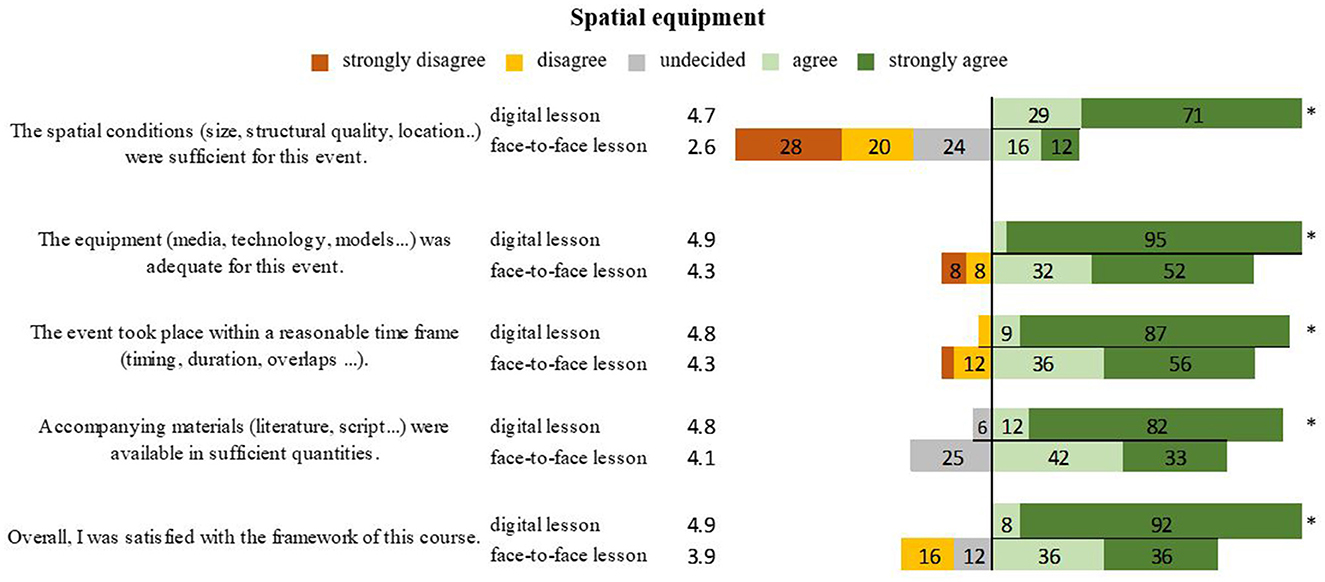
Figure 1. Representation of students' opinions on issues related to space in digital teaching and face-to-face teaching in percentages. *Marks significant differences.
The students rated that participation in virtual classes was better (P = 0.025) than it was for in-person participation (P = 0.939), and there was no significant difference in their overall behavior in digital (4.8) and in-person classes 4.6 (P = 0.180) (Figure 2).

Figure 2. Representation of students' opinions of participation in digital and face-to-face teaching in percentages. *Marks significant differences.
There was no significant difference noticed by the students in lecturers' competencies in terms of communication of goals and structure (P = 0.052), thus allowing questions and assistance (P = 0.178) and creation of a stimulating working atmosphere (P = 0.104) in both lesson forms. In terms of taking up suggestions and questions regarding content (P = 0.017) and placing individual aspects in the overall context (P = 0.004), lecturers were significantly able to better demonstrate their competencies to the students in the virtual form of lessons than in the conventional form with an overall impression of instructor performance being 5.0 and 4.7 (P = 0.026), respectively (Figure 3).
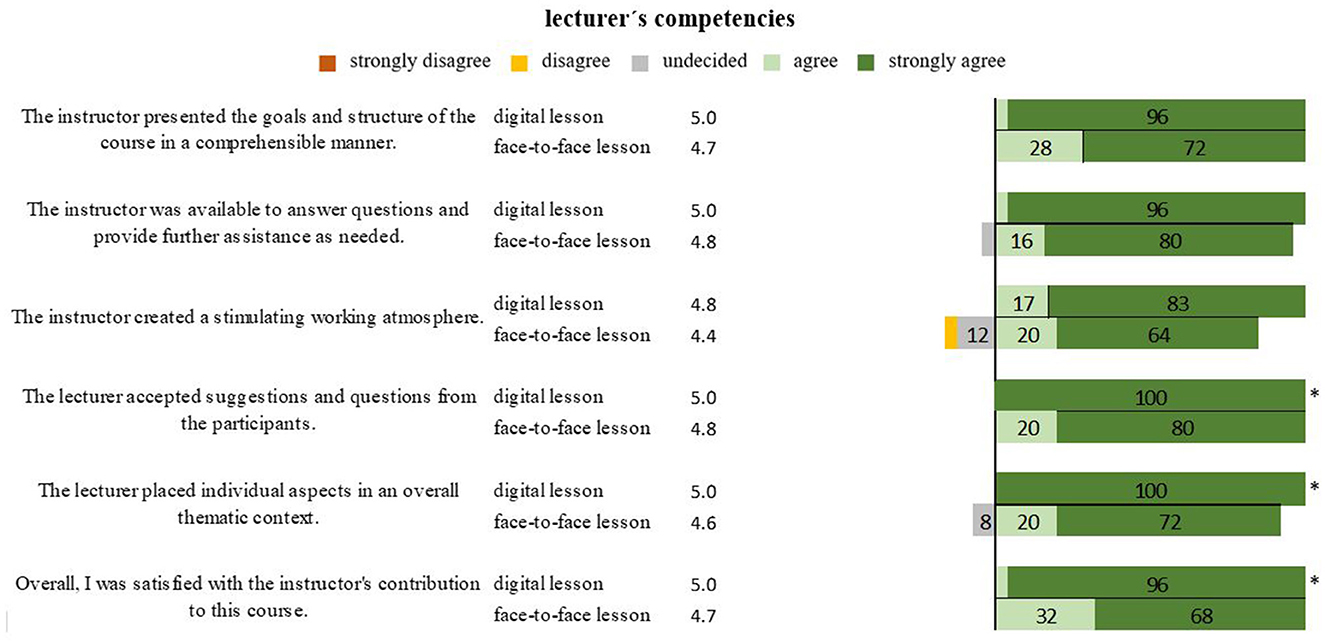
Figure 3. Representation of students' opinions of lecturers in digital and face-to-face teaching in percentages. *Marks significant differences.
The qualification improvement with new knowledge (P = 0.001), research procedures (P = 0.005), practical knowledge (P = 0.023), the acquisition of key competencies (P < 0.001), and the competence of independent and autonomous working (P = 0.006) showed overall better ratings with 4.9 points for digital teaching and 4.4 (P = 0.005) for in-person teaching. The application of knowledge from both lesson forms was equally evaluated (P = 0.346) (Figure 4).
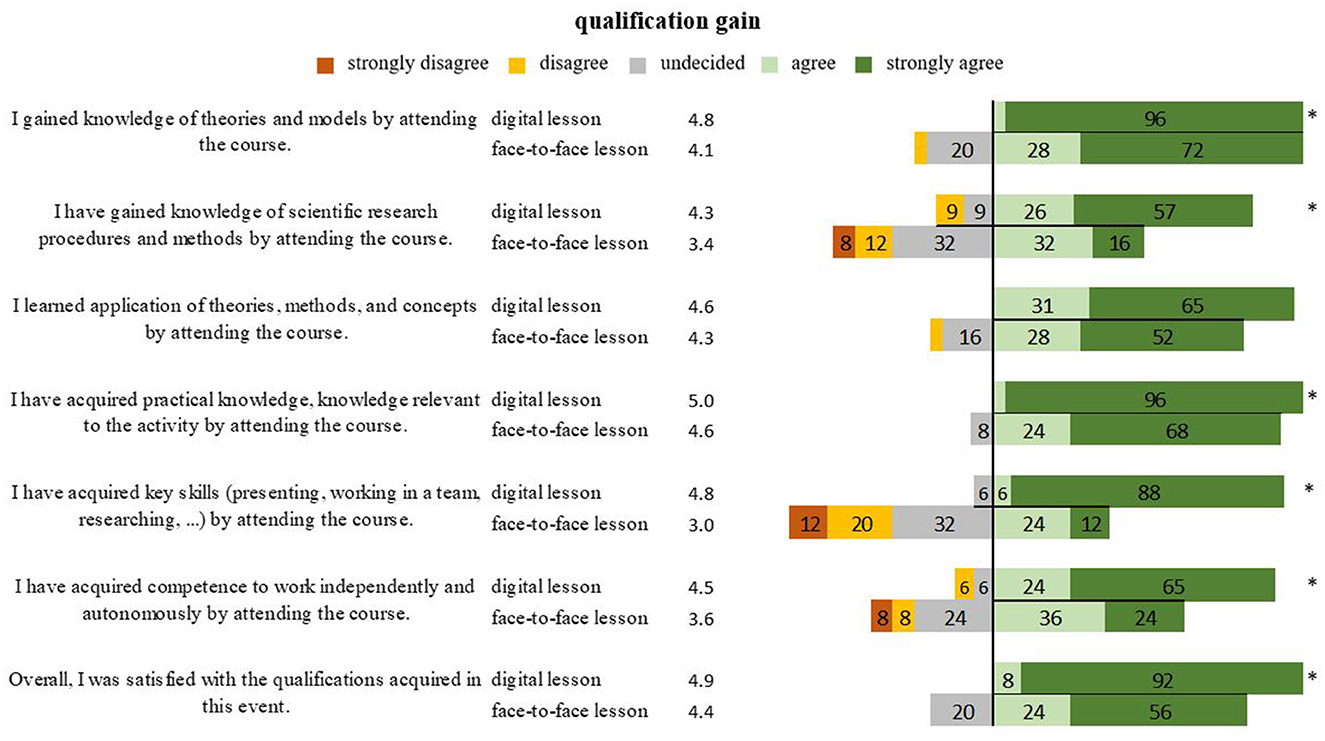
Figure 4. Representation of students' opinions on the skills and knowledge acquired in digital and face-to-face teaching in percentages. *Marks significant differences.
Further aspects such as awakening interest in the topic (P = 0.588) and linking to previous knowledge (P = 0.842) were equally evaluated in the lesson forms. The digital form was recommended to fellow students (P = 0.011), outweighing the conventional teaching, with the overall rating of 4.9 for the digital form being significantly better than 4.4 (P = 0.013) for conventional teaching (Figure 5).
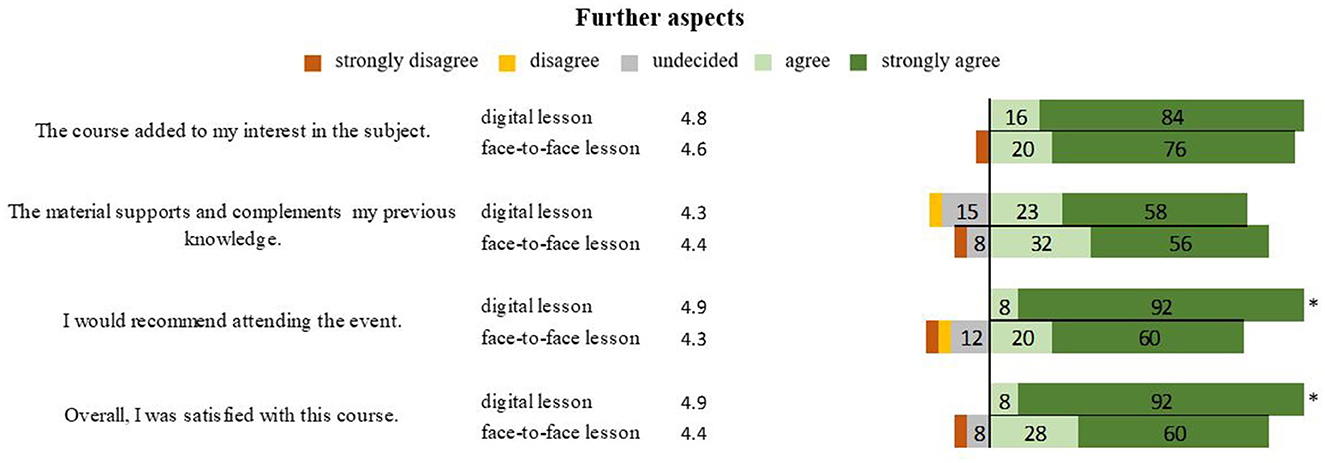
Figure 5. Presentation of students' opinions on the aspects of interesting and recommendable design in digital and face-to-face teaching in percentages. *Marks significant differences.
The overall satisfaction with the course (4.9 vs. 4.4; P = 0.013) and the gain in skills (4.9 vs. 4.4; P = 0.005), and the satisfaction with the instructors (5.0 vs. 4.7; P = 0.026) were predominant for digital teaching. The overall satisfaction with the participants was equally evaluated for both forms (4.7 vs. 4.6; P = 0.596).
Qualitative results
Table 2 visualizes the qualitative results, specifically the five themes with the most-relevant specified subthemes.
Framework conditions
According to the instructors, a controversial picture emerged. The lecturers welcomed the advantages of time management without tiresome travel, the search for parking spaces, and the correct premises. At the same time, they favored their own rooms with a pleasant indoor climate. However, the deficits in the technical conditions of the conventional lecture with compatible equipment (laptop) to the university equipment (connections) also became apparent.
Contact with the students
Contact with the students was experienced as distant and impersonal in the digital lectures compared to conventional in-person events. Lively discussions on the topics did not arise. The lecturers experienced the students as performance-oriented and focused on the lecture. The usually accompanying networking after the lecture, for example as a search for doctoral theses or mentoring partners, was not possible in the digital form of teaching.
Lecturer's own competencies
When asked to self-reflect on the teaching given, the lecturers found it more difficult to convey the teaching, especially the lecture on sports medicine with high practical components as illustrative materials or demonstration of the examination techniques were not possible. The technical innovations required the lecturers to improve their computer situation both with hardware, software, and skills. The acquisition of new skills usually had to be done on one's own initiative and proved to be very time-consuming. All lecturers found it more difficult to assess their teaching success due to the lack of verbal and nonverbal feedback from the students.
Knowledge transfer
The lecturers found the digital lecture form to be more time-consuming for preparation to illustrate the practical parts of the lecture. In particular, the examination techniques could not be demonstrated or improved by practicing. The missing illustrative materials, such as bandaging options could not be demonstrated for better understanding. Overall, it remains more difficult for all the lecturers to assess what the students learned.
Lecturers' opinion on format
The main criticism of virtual lectures in the Sports Medicine course was the unfamiliar impersonal atmosphere. The lecturers found it not only more difficult to assess their teaching success but also more pressure to redesign the lecture for knowledge transfer. They felt diminished self-confidence to teach without student feedback.
Discussion
COVID-19 is an ongoing pandemic and continues to impact everyday life (19). Due to the ongoing pandemic status, the digital ad hoc teaching formats established at the beginning of the COVID-19 pandemic have been established in everyday teaching in the last three pandemic years. Both the students and the lecturers have become accustomed to the new circumstances of knowledge transfer and digital teaching formats at medical universities as they are regularly established as a result (20). This can have advantages as well as disadvantages for both the students and the lecturers. With digital teaching formats, sick students can follow the teaching material from home and sick lecturers can teach from home without quarantine or other people (groups) being infected or endangered (20).
In addition to these advantages, there was also a permanent change compared to digital teaching concepts from the point of view of the students and lecturers. At the beginning of the pandemic, the establishment of digital teaching formats was often viewed negatively from the point of view of the lecturers since the implementation was a major challenge for the lecturers and the medical universities (21). At the beginning of the establishment of digital teaching concepts, the students had a positive attitude, although this attitude changed over the course of the pandemic years (22). The once divergent picture between lecturers and students is getting closer over the course of time. Lecturers were able to acquire digital skills and taught more digitally as students wanted to create more teaching formats in attendance. Therefore, the different reasons are known (23). As one of the main reasons, the explicit students of study by Olmes et al. named the poor quality of the teaching formats in digital form, the lack of human exchange with other students, or even the lecturers (24). In addition, it was complicated and difficult to convey practical teaching content to students through digital teaching formats. There were various reasons and the demand for newly created digital teaching concepts for this topic was great (25). To be able to establish new teaching concepts in the long term, it is important to know the attitude students and lecturers have toward digital teaching formats with complex and practical teaching contents (25). At this point, the present study analyzes the view of the students and lecturers on digital teaching formats and classroom teaching and examined which teaching concept can be applied to complex, practice-oriented teaching contents for the subject of sports medicine in both study groups.
A key advantage of digitization is the ability to automate processes. Many processes in teaching can be automated by digital solutions. These solutions speed up the processes and reduce the barriers from both the students' and lecturers' points of view, as well as reduce the costs of room rentals, travel routes, and energy costs. The biggest challenge is the transformation of classroom learning formats into digital learning formats. From the lecturers' point of view, there are no standardized courses of action for medical teaching at universities. Thus, the implementation of digitization depends or falls on the will and ability of the lecturers (26). As aforementioned in other studies and consistent with the results of the present study, digital formats are used in the longer term if they are user-friendly. This study served as a basis for this. The aim was to survey and verbalize the demands and attitudes of students and lecturers at a medical university during the ad hoc digitization process due to the COVID-19 pandemic. In this way, the present findings can contribute to improving the digitization processes for medical students and lecturers during the current semester. In addition to the positive effects of time management, the lecturers also expressed the reduction in long commuting distances within the clinical routine. This may have a positive effect on practicability; as even in the case of illness, teaching can be carried out by a substitute person or from home. This, in turn, has advantages for the students, as there is less teaching or they feel that they are a burden in the clinical routine of the lecturers. In addition, practical and complex teaching content can be taught using digital processes and manifested from the student's perspective. In the present study, for example, the students rated virtual teaching better for the preparation of active participation in attendance-based courses. The lecturers felt that the digital lecture format was more time-consuming in preparing and illustrating the practical parts of the lecture. In particular, the testing techniques could not be demonstrated or improved by practicing. The missing illustrative materials, such as bandages, could not be shown to better understand these possibilities. Overall, it is still more difficult for all lecturers to assess what the students have learned. Certainly, today's generation of students have grown up in the digital world, while the teachers have had to learn it (27). Sandars et al. (27) showed that students felt that their instructors were willing to improve their digital literacy skills and that some online teaching formats would persist after the COVID-19 pandemic (24). These were confirmed by Theoret and Ming, who found that online teaching and continued online communication could become pillars of medical education (28). Indeed, online teaching has been shown to promote self-learning, be as successful as traditional didactics, and provide an enjoyable experience for participants (29, 30). Overall, although most German medical educators were directly involved in patient care, and therefore, currently under significant stress, the COVID-19 pandemic has offered numerous opportunities for the use of digital media (31). Due to the uncertainty of the lecturers in dealing with digital media and the lack of time resources, the faculties must intervene in a supportive manner. There may be long-term changes due to the pandemic toward teaching using virtual media. Hopefully, the current wave of digitization will continue and the positive effects will persist.
Limitations
The study is based on a survey study. Response bias can skew both student and faculty results. In addition, the maximum number of lecturers surveyed is limited to three. Therefore, the results are only of limited significance and do not reflect the views of lecturers from all the medical universities in Germany. This also applies only to the perspective of the surveyed students. These cannot be transferred uniformly to all students. In addition, the survey of the participants took place only at the University of Jena.
Conclusion
The digital establishment of new tools and formats in teaching is not enough—they must also use sensible and planned basis so that they can also be used sustainably in the field of medical education. The basic prerequisite for the application is to know the attitude and the user needs of the students and lecturers. Regarding this purpose, this study was able to provide fundamental insights. In summary, it can be deduced that digital teaching is actively implemented by the lecturers and students due to the coronavirus pandemic. From a student perspective, digital formats could be used for the preparation and delivery of complex and practice-oriented teaching content. But from the lecturers' point of view, this requires more resources and requires the lecturers to have digital skills. In general, it can be observed that digital formats are in no way inferior to in-person teaching formats, as was assumed for a long time, but positively affects the quality of teaching.
Data availability statement
The original contributions presented in the study are included in the article/supplementary material, further inquiries can be directed to the corresponding author.
Author contributions
IG and SH conceived and planned the experiments. MK performed the analysis. FL, DB, and ES provided critical feedback and helped shape the research, analysis, and manuscript. All authors contributed to the article and approved the submitted version.
Acknowledgments
We thank Debra Weih for English proofreading.
Conflict of interest
MK was employed by the company Jenoptik AG.
The remaining authors declare that the research was conducted in the absence of any commercial or financial relationship that could be construed as a potential Conflict of interest.
Publisher's note
All claims expressed in this article are solely those of the authors and do not necessarily represent those of their affiliated organizations, or those of the publisher, the editors and the reviewers. Any product that may be evaluated in this article, or claim that may be made by its manufacturer, is not guaranteed or endorsed by the publisher.
References
1. Zhang JJ, Dong X, Liu GH, Gao YD. Risk and protective factors for COVID-19 morbidity, severity, and mortality. Clin Rev Allergy Immunol. (2023) 64:90–107. doi: 10.1007/s12016-022-08921-5
2. Sohrabi C, Alsafi Z, O'Neill N, Khan M, Kerwan A, Al-Jabir A, et al. Corrigendum to “world health organization declares global emergency: a review of the 2019 novel coronavirus (COVID-19)”. Int. J. Surg. 76 (2020) 71-76. Int J Surg. (2020) 77:217. doi: 10.1016/j.ijsu.2020.03.036
3. Steffens I. A hundred days into the coronavirus disease (COVID-19) pandemic. Euro surveillance: bulletin Europeen sur les maladies transmissibles = European communicable disease bulletin. (2020) 25:1–4. doi: 10.2807/1560-7917.ES.2020.25.14.2000550
4. Baloch S, Baloch MA, Zheng T, Pei X. The coronavirus disease 2019 (COVID-19) pandemic. Tohoku J Exp Med. (2020) 250:271–8. doi: 10.1620/tjem.250.271
5. Melnick ER, Ioannidis JPA. Should governments continue lockdown to slow the spread of covid-19? BMJ. (2020) 369:m1924. doi: 10.1136/bmj.m1924
6. Sheikh A, Anderson M, Albala S, Casadei B, Franklin BD, Richards M, et al. Health information technology and digital innovation for national learning health and care systems. Lancet Digit Health. (2021) 3:e383–96. doi: 10.1016/S2589-7500(21)00005-4
7. Tanveer F, Khalil AT, Ali M, Shinwari ZK. Ethics, pandemic and environment; looking at the future of low middle income countries. Int J Equity Health. (2020) 19:182. doi: 10.1186/s12939-020-01296-z
8. Jowsey T, Foster G, Cooper-Ioelu P, Jacobs S. Blended learning via distance in pre-registration nursing education: a scoping review. Nurse Educ Pract. (2020) 44:102775. doi: 10.1016/j.nepr.2020.102775
9. Hertling S, Hertling D, Matziolis G, Schleußner E, Loos F, Graul I. Digital teaching tools in sports medicine: a randomized control trial comparing the effectiveness of virtual seminar and virtual fishbowl teaching method in medical students. PLoS ONE. (2022) 17:e0267144. doi: 10.1371/journal.pone.0267144
10. Hunck S, Engelhard K, Mildenberger P, Kurz S. Chancen und herausforderungen der zunehmenden digitalisierung der lehre im fach anästhesiologie aus sicht der studierenden [chances and challenges of increasing digitalization of teaching in the discipline anesthesiology from the perspective of students]. Anaesthesiologie. (2022) 71:689–96. doi: 10.1007/s00101-022-01102-1
11. Ruiz JG, Mintzer MJ, Leipzig RM. The impact of E-learning in medical education. Acad Med. (2006) 81:207–12. doi: 10.1097/00001888-200603000-00002
12. Abi-Rafeh J, Azzi AJ. Emerging role of online virtual teaching resources for medical student education in plastic surgery: COVID-19 pandemic and beyond. J Plast Reconstr Aesthet Surg. (2020) 73:1575–92. doi: 10.1016/j.bjps.2020.05.085
13. Kay D, Pasarica M. Using technology to increase student (and faculty satisfaction with) engagement in medical education. Adv Physiol Educ. (2019) 43:408–13. doi: 10.1152/advan.00033.2019
14. Emanuel EJ. The inevitable reimagining of medical education. JAMA. (2020) 323:1127–8. doi: 10.1001/jama.2020.1227
15. Wittbecker LM, Pham C, Wohlgemuth LK, Hoang MA, Bandholz TC, Schuh S, et al. Digitale und innovative Lehre in der Dermatologie: Praktisch orientierte Lehre online [Digital and innovative teaching in dermatology: Practically oriented teaching online]. Dermatologie. (2022) 73:829–37. doi: 10.1007/s00105-022-05062-w
16. Khalil R, Mansour AE, Fadda WA, Almisnid K, Aldamegh M, Al-Nafeesah A, et al. The sudden transition to synchronized online learning during the COVID-19 pandemic in Saudi Arabia: a qualitative study exploring medical students' perspectives. BMC Med Educ. (2020) 20:285. doi: 10.1186/s12909-020-02208-z
17. Engel AL, Müller A, Spät H, Kurz S, Hoffmann EM. Deutschlandweite Befragung der Lehrbeauftragten in der Augenheilkunde zur studentischen Lehre in der Corona-Pandemie 2020/21 [German national survey of lecturers in ophthalmology on student teaching in the 2020/21 corona pandemic]. Ophthalmologie. (2022) 119:611–8. doi: 10.1007/s00347-021-01544-9
18. Dubois A, Gadde L-E. Systematic combining: an abductive approach to case research. J Bus Res. (2002) 55:553–60. doi: 10.1016/S0148-2963(00)00195-8
19. Hossain MM, Sultana A, Purohit N. Mental health outcomes of quarantine and isolation for infection prevention: a systematic umbrella review of the global evidence. Epidemiol Health. (2020) 42:e2020038. doi: 10.4178/epih.e2020038
20. Riedel M, Amann N, Recker F, Hennigs A, Heublein S, Meyer B, et al. The COVID-19 pandemic and its impact on medical teaching in obstetrics and gynecology-A nationwide expert survey among teaching coordinators at German university hospitals. PLoS ONE. (2022) 17:e0269562. doi: 10.1371/journal.pone.0269562
21. Scherg A, Ilse B, Elsner F. Palliativmedizinische Lehre im Querschnittsbereich 13 unter dem Einfluss von COVID-19 [Undergraduate palliative care teaching in times of COVID-19]. Schmerz. (2021) 35:237–41. doi: 10.1007/s00482-021-00548-3
22. Holzmann-Littig C, Zerban NL, Storm C, Ulhaas L, Pfeiffer M, Kotz A, et al. One academic year under COVID-19 conditions: two multicenter cross-sectional evaluation studies among medical students in Bavarian medical schools, Germany students' needs, difficulties, and concerns about digital teaching and learning. BMC Med Educ. (2022) 22:450. doi: 10.1186/s12909-022-03480-x
23. Fehl M, Gehres V, Geier AK, Mundt T, Klinge K, Frese T, et al. Medical students' adoption, and evaluation of a completely digital general practice clerkship - cross-sectional survey and cohort comparison with face-to-face teaching. Med Educ Online. (2022) 27:2028334. doi: 10.1080/10872981.2022.2028334
24. Olmes GL, Zimmermann JSM, Stotz L, Takacs FZ, Hamza A, Radosa MP, et al. Students' attitudes toward digital learning during the COVID-19 pandemic: a survey conducted following an online course in gynecology and obstetrics. Arch Gynecol Obstet. (2021) 304:957–63. doi: 10.1007/s00404-021-06131-6
25. Dost S, Hossain A, Shehab M, Abdelwahed A, Al-Nusair L. Perceptions of medical students towards online teaching during the COVID-19 pandemic: a national cross-sectional survey of 2721 UK medical students. BMJ Open. (2020) 10:e042378. doi: 10.1136/bmjopen-2020-042378
26. Baqir SM, Mustansir F. Online medical education and examinations during COVID-19: perspectives of a teaching associate. J Coll Physicians Surg Pak. (2021) 30:S16–S18. doi: 10.29271/jcpsp.2021.01.S16
27. Sandars J, Correia R, Dankbaar M, de Jong P, Goh P, Hege I, et al. Twelve tips for rapidly migrating to online learning during the COVID-19 pandemic. MedEdPublish. (2020) 9. doi: 10.15694/mep.2020.000082.1
28. Theoret C, Ming X. Our education, our concerns: the impact on medical student education of COVID-19. Med Educ. (2020) 54:591–2. doi: 10.1111/medu.14181
29. Huynh R. The role of e-learning in medical education. Acad Med. (2017) 92:430. doi: 10.1097/ACM.0000000000001596
30. Taylor D, Grant JF, Hamdy H, Grant L, Marei H, Venkatramana M. Transformation to learning from a distance. MedEdPublish. (2020) 9:1–19. doi: 10.15694/mep.2020.000076.1
Keywords: digital teaching, virtual teaching, sports medicine, e-learning, medical education, COVID
Citation: Hertling SF, Back DA, Kaiser M, Loos FM, Schleußner E and Graul I (2023) Students' and lecturers' perspectives on the implementation of online learning in medical education due to COVID-19 in Germany: a cross-sectional pilot study. Front. Med. 10:1145651. doi: 10.3389/fmed.2023.1145651
Received: 16 January 2023; Accepted: 28 February 2023;
Published: 24 April 2023.
Edited by:
Pradeep Sahu, The University of the West Indies St. Augustine, Trinidad and TobagoReviewed by:
Srikanth Umakanthan, The University of the West Indies St. Augustine, Trinidad and TobagoNerissa Naidoo, Mohammed Bin Rashid University of Medicine and Health Sciences, United Arab Emirates
Copyright © 2023 Hertling, Back, Kaiser, Loos, Schleußner and Graul. This is an open-access article distributed under the terms of the Creative Commons Attribution License (CC BY). The use, distribution or reproduction in other forums is permitted, provided the original author(s) and the copyright owner(s) are credited and that the original publication in this journal is cited, in accordance with accepted academic practice. No use, distribution or reproduction is permitted which does not comply with these terms.
*Correspondence: Stefan F. Hertling, c3RlZmFuLmhlcnRsaW5nQHlhaG9vLmRl
 Stefan F. Hertling
Stefan F. Hertling David A. Back3,4
David A. Back3,4